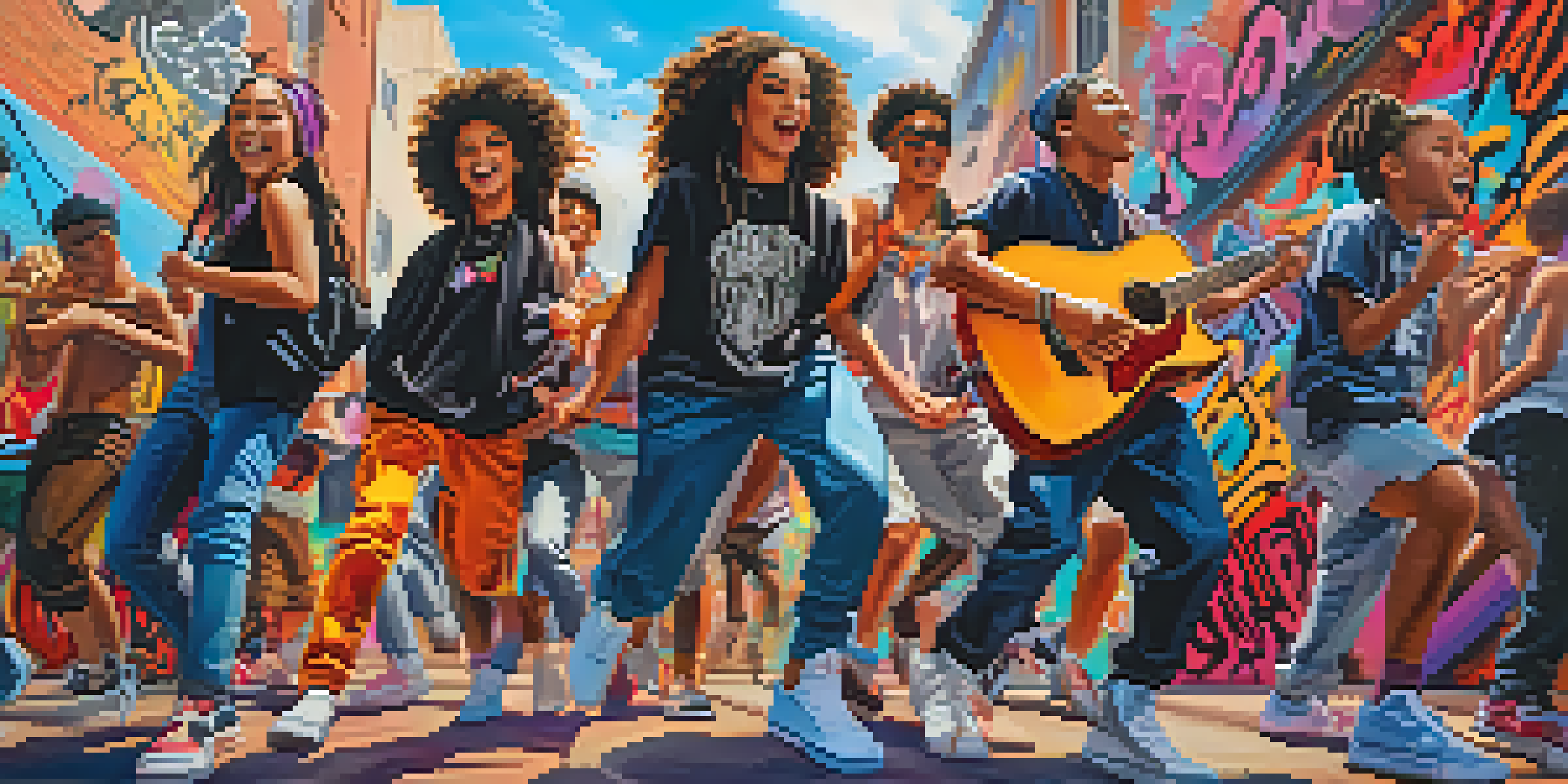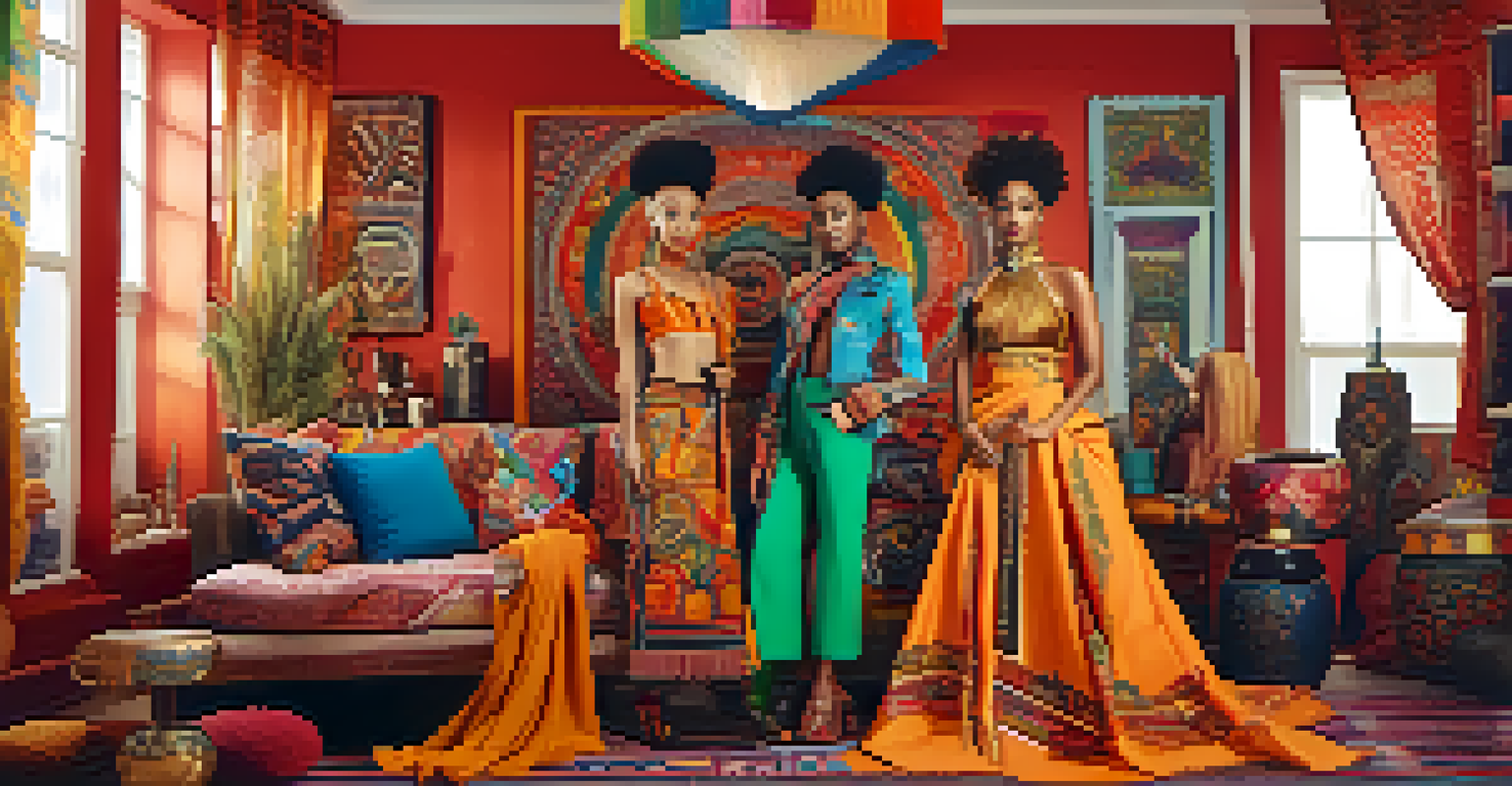The Role of Music Videos in Personal Expression and Identity

Music Videos: A Canvas for Personal Expression
Music videos have evolved into powerful tools for artists to express their individuality. Through visuals, they convey emotions and themes that often resonate deeply with viewers. For many fans, these videos serve as a mirror reflecting their own feelings and experiences, creating a sense of connection and personal identification.
Music can change the world because it can change people.
Take, for example, a pop artist who uses vibrant colors and bold fashion choices in their music video. These elements can symbolize freedom and self-acceptance, inviting viewers to embrace their unique identities. In this way, music videos do more than entertain; they empower individuals to celebrate their true selves.
As we explore the landscape of personal expression in music videos, it becomes clear that these visual narratives are essential in shaping how we view ourselves and our place in the world. They encourage us to find our voice and express our identity in ways that feel authentic.
Cultural Identity and Music Videos: A Dynamic Fusion
Music videos often serve as cultural touchstones, showcasing the diverse backgrounds and stories of artists. They can highlight cultural traditions, fashion, and languages, creating a rich tapestry that speaks to various identities. By incorporating elements from their heritage, artists invite viewers to explore and appreciate different cultures.

Consider the influence of hip-hop music videos, which frequently feature urban settings and street culture. This not only reflects the artists' backgrounds but also resonates with fans who share similar experiences. Such representation allows viewers to connect on a deeper level, fostering a sense of belonging and pride in their cultural roots.
Music Videos as Personal Expression
Music videos empower artists and viewers to express their identities and emotions through compelling visuals.
In this way, music videos act as bridges between cultures, allowing for an exchange of ideas and values. They celebrate diversity while also challenging stereotypes, demonstrating how art can be a powerful vehicle for cultural expression and understanding.
The Impact of Visual Storytelling in Music Videos
Visual storytelling is a crucial aspect of music videos that enhances the narrative behind the song. The combination of imagery, choreography, and lyrics creates a multi-layered experience that captivates audiences. This storytelling aspect not only entertains but also evokes emotions that can significantly impact personal identity.
Art is the most beautiful of all lies.
For instance, a music video that tells a story of overcoming adversity can inspire viewers facing similar challenges. The visuals serve as a source of motivation, reminding them that they are not alone in their struggles. This connection can be powerful, encouraging individuals to embrace their journey and share their stories.
Ultimately, the art of visual storytelling in music videos adds depth to the music, making it relatable and impactful. It transforms a simple song into a poignant experience that resonates with viewers on a personal level.
Emotional Resonance: Connecting Through Music Videos
Music videos often evoke strong emotions, allowing viewers to connect with the artist and their message. This emotional resonance can foster a sense of community among fans who share similar feelings. Whether it's joy, nostalgia, or sadness, these videos create a space for individuals to process their emotions together.
Take a heart-wrenching ballad, for example. The accompanying music video may depict a poignant story of love and loss, making viewers reflect on their own experiences. This shared emotional journey can lead to discussions and connections among fans, further reinforcing their identities within a community.
Cultural Identity Through Visuals
By showcasing cultural elements, music videos foster appreciation and understanding of diverse backgrounds.
This emotional bond created by music videos highlights the power of music as a universal language. It reminds us that while our circumstances may differ, our feelings often unite us, making music videos a vital part of personal and collective expression.
The Role of Fashion in Music Videos and Identity
Fashion plays a significant role in music videos, often serving as a visual representation of an artist's identity. The clothes, accessories, and overall style portrayed in a video can communicate messages about cultural background, social status, and personal aesthetics. This visual language allows artists to express themselves and connect with fans who resonate with their style.
For instance, a music video showcasing bold streetwear may appeal to younger audiences who identify with that fashion trend. By wearing specific styles, artists can create a sense of belonging and influence their viewers' fashion choices. This exchange highlights how music and fashion intertwine to shape personal identities.
Moreover, fashion in music videos can inspire viewers to experiment with their looks, encouraging self-expression through clothing. Whether it's embracing a unique style or adopting elements from various cultures, these visual cues empower fans to celebrate their identities in creative ways.
Social Commentary and Identity in Music Videos
Many music videos serve as platforms for social commentary, addressing pressing issues like inequality, mental health, and social justice. By tackling these subjects, artists not only make their voices heard but also encourage viewers to reflect on their own identities and beliefs. This engagement can spark conversations and inspire action within communities.
For instance, a music video highlighting environmental concerns can resonate with viewers who are passionate about sustainability. By connecting the artist's message to their own values, fans may feel compelled to take action, further solidifying their identity as advocates for change. This demonstrates the power of music videos to influence personal and collective identities.
Storytelling Drives Emotional Connection
Visual storytelling in music videos evokes emotions, creating a shared experience that strengthens community bonds among fans.
In essence, social commentary within music videos acts as a catalyst for transformation, prompting viewers to examine their roles in society. It encourages individuals to find their voice and contribute to important conversations, ultimately enriching their personal identities.
The Evolution of Music Videos: A Reflection of Identity
The evolution of music videos over the years reflects changing societal norms and attitudes toward identity. From the early days of simple performance clips to today's visually stunning narratives, music videos have become a vital part of the music industry. This evolution mirrors the ways in which individuals express themselves and their identities in an ever-changing world.
As technology advances, artists are able to incorporate various styles and formats into their videos, allowing for greater creativity and expression. This shift not only enhances the visual experience but also encourages artists to explore complex themes related to identity, culture, and emotion. The versatility of music videos has opened up new avenues for personal expression.

In conclusion, the progression of music videos highlights the dynamic relationship between art and identity. As they continue to evolve, they will undoubtedly remain a significant medium for self-expression and cultural representation.